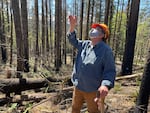
Dave Shaw, an Oregon State University professor and forest health specialist, scrapes char off the bark of a burned tree marked for removal off Oregon Highway 22.
Cassandra Profita / OPB
Gates Mayor Ron Carmickle is walking alongside a grove of burned trees off Highway 22 near his city in Oregon’s Santiam Canyon.
“The ones you can see here are marked,” he said, pointing to a line of trees with blue spray paint on their trunks.
He’s brought two tree experts with him: arborist Rick Till and forest health specialist Dave Shaw with Oregon State University.
“That one’s got pretty high scorch,” Shaw said, pointing to one with blackened bark stretching more than halfway up the trunk and then moving on to another tree with less bark scorch. “This one’s a little edgy.”
The blue spray paint is how contractors with the Oregon Department of Transportation are marking what are deemed to be hazardous trees within areas that were burned in last year’s wildfires and need to be cut down for safety.
ODOT’s goal in the state’s ongoing hazard tree removal operation is to protect people from burned trees that could fall onto roads or buildings. But deciding which trees actually pose that risk is complicated, and a growing number of people say ODOT’s contractors are hastily marking too many trees for removal — including trees that aren’t actually hazardous.
The operation faces multiple allegations of mismanagement and excessive tree-cutting. Gov. Kate Brown has allowed the work to continue despite calls to stop the project and order an investigation, but state lawmakers are asking a lot of questions, and critics like Carmickle are taking a closer look at the trees marked for removal.
He invited Till and Shaw to come check the state’s work by examining some of the trees with blue dots.

Oregon State University forest health specialist Dave Shaw looks at the crowns of trees marked for removal off Oregon Highway 22 near Mill City.
Cassandra Profita / OPB
Shaw uses an axe to scrape away a thin layer of blackened bark on a Douglas fir tree that’s marked with a blue dot. Just under the surface, the bark is golden brown.
“See how limited the char is?” he said. “That’s not really severe bark char. It’s not really deep.”
But the top of the tree doesn’t look very healthy, he said, so he wouldn’t challenge that removal decision. In contrast, Shaw points to another tree with a blue dot that has black bark but is full of green needles on top. That’s probably going to live, he said, so it doesn’t need to be cut down for safety.
“The crown is completely undamaged,” he said. “I don’t know. I’m suspicious about this tree. I mean, that one in particular doesn’t really look like a high likelihood of mortality.”
Carmickle says that kind of conclusion adds to his concerns that ODOT contractors are over-cutting trees just to make more money. And he wants to stop them before they cut any more of the blue-dotted trees in his city.
“I mean, these trees are 60, 80 years old, it’s going to take that long for this to rejuvenate,” he said. “So that’s what we’re facing in this here. When they just clear-cut all this stuff out, we’re facing, you know, a whole generation before this ever comes back.”
The mayor’s fears are compounded by firsthand reports from multiple people who worked on the state’s hazard tree removal project.

Gates Mayor Ron Carmickle, right, talks with forest health specialist Dave Shaw with Oregon State University, left, and arborist Rick Till.
Cassandra Profita / OPB
Eric Phillips is one of several whistleblowers who told lawmakers about the problems he saw while working for an ODOT contractor on Highway 224.
“It was a very ‘Hurry up. Let’s get trees cut and cut as many trees as we can,’” Phillips said in a recent legislative hearing. “There’s so much mismanagement. So much lack of accountability. It’s like people just want to get paid.”
He said workers with no arborist experience were marking trees for removal that he saw contractors falling trees into wetlands and cutting trees that weren’t marked as hazardous, and that he didn’t see anyone making sure the rules were followed.
“There’s no oversight out there in the field at all,” he said.
After the hearings, Sen. Jeff Golden asked the governor to stop the project and order an investigation.
“We’d better get real clear on what’s going on out there now, soon,” the Ashland Democrat said. If we’ve gone astray, if this project has gone astray, let’s find out and correct it right now.”
He worries the state could lose federal disaster funding.
So far, ODOT and its contractors say they’ve fixed many of the reported problems.
ODOT manager Mac Lynde told lawmakers his agency has hired an independent arborist to review the tree-cutting operation in response to the litany of complaints.
In a hearing Monday, Lynde told the Senate Committee on Natural Resources and Wildfire Recovery that the state hired Galen Wright, president of Washington Forest Consultants, Inc. and an arborist with 30 years of experience in hazard tree identification.
“We’re up to 1,200 people on this project,” Lynde told lawmakers. “I have a high degree of confidence that it’s going well, but let’s face it. That’s a lot of people and a lot of moving parts. So, we’re asking him to come on and quite quickly, review the operation in several fire corridors.”
Over the next three weeks, Lynde said, Wright will be reviewing the qualifications of the arborists and foresters working on the state project, the criteria being used to mark trees for removal and the overall process the state is using to mark and remove hazard trees.
“He won’t be looking at every single tree again or really every fire corridor, every mile we’ve covered, but we’re asking him to look at a representative sample and confirm before the trees come down that it matches with the expectations of what our program is designed around,” Lynde said. “We hope this will build more confidence with others around our project. At minimum, I think it will validate some of the work that’s been going on or it will help inform additional changes.”
Lynde said the Oregon Secretary of State will also be auditing the project, and that the state’s monitoring firm, CDR Maguire, has initiated its own internal review in response to the whistleblower allegations.
“As more information comes out about what those reviews identify, we’ll certainly take swift action,” Lynde said.
But environmental groups are still calling on the governor to stop the tree-cutting and activists recently forced the work to stop by occupying a tree-removal site east of Eugene. ODOT has also reported some activists spray painting over the blue dots on marked trees to prevent falling crews from cutting them down.
At a rally in Salem last week, protesters dressed up in various costumes and chanted: “Governor Brown, stop the cut!”
ODOT and the governor say wildfire recovery is too important to stop the removal of hazardous trees. They want to make sure roads can reopen and homeowners can rebuild on their burned properties, and they say the state can continue to address the reported problems without stopping the project altogether.
Right now, the state is about a quarter of the way through marking and removing an estimated 140,000 hazard trees left by last year’s wildfires.
“Certainly our emergency response operation is an adaptive operation, and it looks a lot different today than when we started,” Lynde told lawmakers on Monday. “This is something that has never happened before in Oregon. Never has a program this size been launched. As we recover from these wildfires, we’re constantly refining our operation and learning from our experiences.”
